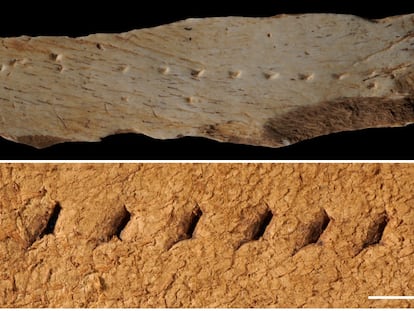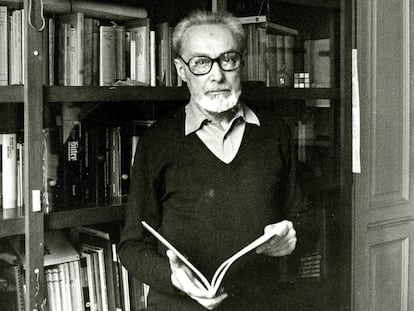Synagogues, cemeteries, and settlements: Spain’s hidden Jewish heritage
The expulsion of the Jews in 1492 buried homes and synagogues standing for more than a thousand years in the Iberian Peninsula
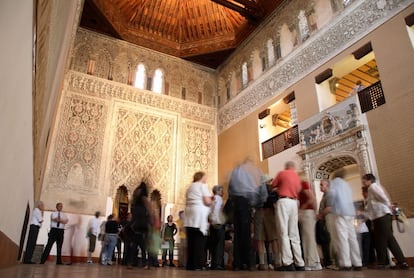

Born in 1352, Salomón Haleví was not only a member of a Hebrew family in charge of collecting taxes for the kingdom of Castile, but also the chief rabbi of Burgos. Around 1390, when the Jewish community was about to be massacred, he converted to Christianity and became Pablo de Santa María, bishop of Cartagena. Haleví's life has much in common with what happened to Hebrew heritage in the Iberian Peninsula. Rather than being wiped out altogether, it underwent a transformation, as was confirmed last February when work on a nightclub in Utrera, Seville, exposed a spectacular synagogue about whose existence little was known.
It was not the first Jewish monument to be stumbled upon. In 2002, within the walls of the castle in Lorca, in the southeastern region of Murcia, another Hebrew temple was found. In 2010, while remodeling the church of Santa María la Blanca in Seville, the remains of a 13th-century synagogue were discovered, while two years later, in Segovia, a Jewish cemetery dating back five centuries was uncovered during the construction of a sewer. It is a cultural and architectural heritage existing in many Spanish and Portuguese cities that is sometimes difficult to detect, even when walking through a medieval quarter.
It all began in 586 B.C., when the Babylonian armies of Nebuchadnezzar II destroyed the First Temple in Jerusalem and put an end to biblical Israel. The majority of the city’s inhabitants were taken prisoner and dragged to Babylon, while the survivors were scattered, as a great diaspora, throughout the Mediterranean. “When the temple was demolished, Judaism was left without an architectural place of reference and resurfaced as a thought or belief system,” explains Nuria Morere, professor of history at King Juan Carlos University in Madrid.
In the documents preserved from the Synod of Elvira in Granada at the beginning of the 4th century, there is already evidence of a Jewish presence in Hispania. These were immigrants who sought resources for survival on the Mediterranean coast, mainly in Elche and Tarragona, but also in the larger cities such as Mérida, in what is today western Spain. “Basically, when a people have no roots, they dedicate themselves to ephemeral things, such as trade, which [in the case of the Jews] would remain stable until the Middle Ages, when they began to work as moneylenders for the monarchs, although they developed all kinds of trades,” Morere explains.
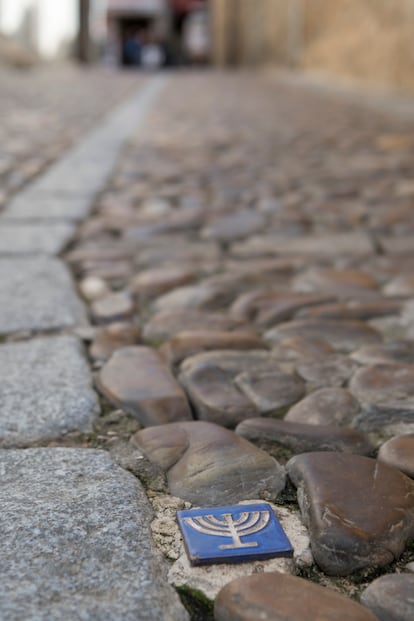
León Benelbas, former president of the Jewish Community of Madrid, agrees that “the main Hebrew contribution to the Iberian Peninsula was cultural. The Golden Age of Judaism took place in medieval Spain, something which is recognized across the world,” he says. “There was little they could contribute from the patrimonial point of view because they lacked territory and lands as they could not get their hands on a duchy or a marquisate, irrespective of the merits accumulated. Then, the synagogues, the assistance centers, the neighborhoods they built either disappeared or were transformed when they were expelled in 1492.”
In general, Jewish neighborhoods were very similar to those of the Christians and Muslims, but with certain touches specific to their culture. At the end of the 12th and beginning of the 13th centuries, Jews flocked from the countryside to the cities, where they specialized in trade and crafts. “Ranging from the most humble to the most refined artisan activity, there was no trade that was not practiced by the Jews of Sepharad,” says historian Andreu Lascorz.
It is an opinion shared by architect Abraham Hassan, who is currently holding an exhibition on synagogue architecture at the Sefarad-Israel Center in Madrid: “Jewish architecture in the Iberian Peninsula is nothing more than an adaptation of what already existed in Spain,” he says. “With the odd exception, they did not create large buildings. The magnificent Hebrew architects are contemporary, not medieval.”
The Jewish quarter was, according to Lascorz, the neighborhood “of the entire community where most of its activities took place. It was the Hebrew city managed down to the smallest detail by the leaders,” he says. “The Jewish quarters mostly had gates which were closed at night as a precaution and also at Easter to protect against assaults or, at other times, against violent outbreaks such as those in 1348 and 1391.”
It is known that there were stable settlements in large cities such as Alcalá de Henares, Barcelona, Burgos, Cáceres, Córdoba, Girona, Granada, Guadalajara, Jaén, Palma and Zaragoza, as well as in smaller municipalities such as Rivadavia, Tui, Plasencia and Tarazona. Scholars estimate that at its peak in the 13th and 14th centuries, the Jewish community swelled to 250,000 in an Iberian Peninsula with a population of around 4.5 million.
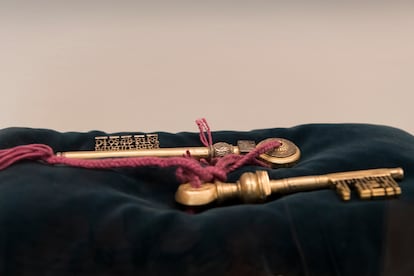
The El Tránsito synagogue, alternatively known as the synagogue of Samuel ha-Levi, located in Toledo, has, according to Benelbas, “no parallel in Europe or even in the world. Not even in the Holy Land is there such a monument.” It is a 14th-century building, erected by Samuel ha-Levi, treasurer during the reign of King Peter I. It was built in the Mudejar style and is known for its Great Prayer Hall, and features multi-foil arches, polychrome stucco-work, Arabic inscriptions and quotations from the Psalms as well as plant and heraldic motifs of the kingdom of Castile.
After the expulsion of the Jews from Spain by the Catholic monarchs, Jewish assets were kept by the Church and converted to its needs. For example, the synagogue of Samuel Levi Abulafia was transformed into a hospital, which miraculously saved it from being reduced to rubble. Something similar happened with the Greater Synagogue of Toledo, which became the church of Santa María la Blanca. “These are real gems,” says Benelbas. “Their existence is exceptional, because the Jews were not allowed to build.”
The existence of Jewish quarters, however, is more common as their layouts and houses are preserved in the historical areas of medieval Spanish and Portuguese cities, such as Córdoba, Seville, Girona, Toledo and Saporta. Within these quarters, the men worked as gunsmiths, butchers, carpenters, locksmiths, merchants, pharmacists, booksellers, notaries, tailors and silversmiths, while the women worked as midwives, spinners, washerwomen and weavers. The most prestigious jobs were those of kabbalists, cartographers, scientists, philosophers, geographers, poets, polemicists, Talmudists, translators, and doctors.
Lascorz explains that “the homes in a Jewish quarter were no different from other Christian and Moorish dwellings.” In the Jewish quarters there were “synagogues and oratories, as well as schools, baths, hospitals, bakeries, wine cellars, butchers, markets, squares and taverns. And in the most important Jewish quarters: brothels. The cemeteries were built outside the cities for religious reasons,” he adds.
Meanwhile, Morere says that the Jews “were no different from the rest of the population. The difference was created by us, by Christianity, by Catholicism, but it was not in fact so real in the society of that era. The real change came later with the creation of the ghettos, in response to a 19th-century line of thought based on the so-called Protocols of the Elders of Zion, which argued that the Jews were a source of evil in the world.” In the 3rd and 4th centuries, the professor insists, “they were only a minority, with a religion not too different from Christianity, but the Church decided to distance itself from Judaism and, gradually, segregation took root.”
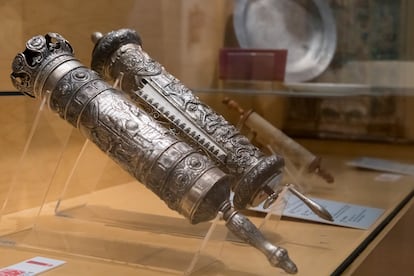
Nevertheless, Jews continued to arrive in the peninsular Christian kingdoms throughout the Middle Ages. According to the experts: “There had been expulsions in Europe and the Almohad and Almoravid empires were still at war [in the south of the Iberian peninsula] which caused many to emigrate north to Christian territories. Some monarchs persecuted them and others protected them.” The end came with the Catholic monarchs, who were determined to achieve an absolute monarchy for which they required a cast-iron Catholicism.
Benelbas explains that to avoid being expelled, many Jews argued that they had been in the Peninsula for thousands of years: since about two centuries before the death of Christ. “A naïve and desperate argument used to contend that if they were in Spain before the beginning of the Common Era [I B.C.], they had nothing to do with what others had done.” It is estimated that about half of the Jews in the Peninsula, amounting to 100,000, refused to embrace Christianity and were expelled.
In 1432, Salomón Haleví, aka Pablo de Santa María, finished his greatest work, Scrutinium Scripturarum, a controversial treatise, according to the Royal Academy of History; with only 60 years remaining before the definitive expulsion of the Jews, it sketched an open dialogue between a Christian and a Jew. In it, the author highlighted the “errors” of the Hebrew religion. So convinced was he by his new faith that almost his entire family converted to Christianity. His son Gonzalo, for example, was named bishop of three dioceses, another descendant became Alonso of Burgos, and his granddaughter, Teresa de Cartagena, entered a convent and became one of the great authors of Castilian literature. Like the monuments recently uncovered, Haleví left little trace of his Jewish origins.
Sign up for our weekly newsletter to get more English-language news coverage from EL PAÍS USA Edition
Tu suscripción se está usando en otro dispositivo
¿Quieres añadir otro usuario a tu suscripción?
Si continúas leyendo en este dispositivo, no se podrá leer en el otro.
FlechaTu suscripción se está usando en otro dispositivo y solo puedes acceder a EL PAÍS desde un dispositivo a la vez.
Si quieres compartir tu cuenta, cambia tu suscripción a la modalidad Premium, así podrás añadir otro usuario. Cada uno accederá con su propia cuenta de email, lo que os permitirá personalizar vuestra experiencia en EL PAÍS.
¿Tienes una suscripción de empresa? Accede aquí para contratar más cuentas.
En el caso de no saber quién está usando tu cuenta, te recomendamos cambiar tu contraseña aquí.
Si decides continuar compartiendo tu cuenta, este mensaje se mostrará en tu dispositivo y en el de la otra persona que está usando tu cuenta de forma indefinida, afectando a tu experiencia de lectura. Puedes consultar aquí los términos y condiciones de la suscripción digital.
More information
Archived In
Últimas noticias
Maduro pleads not guilty before the federal court in New York: ‘I am still the president of Venezuela’
A new test can detect Alzheimer’s from a finger prick
UN team enters Sudanese city of El Fasher after paramilitary massacre: ‘It’s like a ghost town’
A recipe for resistance: Indigenous peoples politicize their struggles from the kitchen
Most viewed
- Gilles Lipovetsky: ‘If you want to live better and fall in love, take Prozac, don’t look to philosophy’
- Alain Aspect, Nobel laureate in physics: ‘Einstein was so smart that he would have had to recognize quantum entanglement’
- Alvin Hellerstein, a 92-year-old judge appointed by Bill Clinton, to preside over Maduro’s trial in New York
- Maduro’s downfall puts China’s relationship with Venezuela to the test
- Why oil has been at the center of Venezuela-US conflicts for decades
